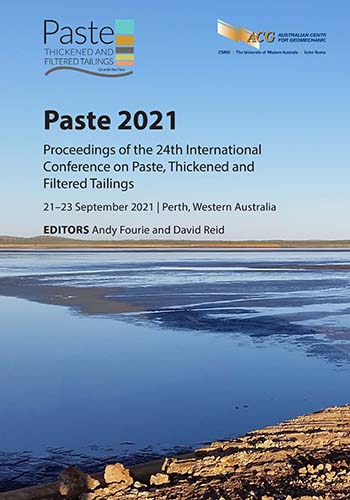Thickened tailings loop test to corroborate the hydraulic Hanks model and Buckingham equation

|
Authors: Vilela, L; Pinto, D; Ramos, G |
DOI https://doi.org/10.36487/ACG_repo/2115_12
Cite As:
Vilela, L, Pinto, D & Ramos, G 2021, 'Thickened tailings loop test to corroborate the hydraulic Hanks model and Buckingham equation', in AB Fourie & D Reid (eds), Paste 2021: Proceedings of the 24th International Conference on Paste, Thickened and Filtered Tailings, Australian Centre for Geomechanics, Perth, pp. 131-142, https://doi.org/10.36487/ACG_repo/2115_12
Abstract:
The disposal of diluted tailings in dams, due to their muddy state, becomes inherently difficult to contain and this poses a high risk to society, as observed in the last two accidents that occurred in Brazil in 2015 and 2019. Therefore, the disposal of coarser tailings becomes more relevant because besides contributing to the reduction of water consumption and environmental impact, it will also require a smaller disposal area. However, to transport a thicker slurry, the viscosity and the yield stress of the tailings will increase. Therefore, for long distance conveying systems, high friction losses are generated in the pipeline. In view of the high operating pressures and the low experience with these pumping systems, it is important to consolidate the hydraulic model used in the design. The loop test setup in this case was used to support the selected hydraulic model. Based on data from a loop test set up at a Brazilian mining company located in the Iron Quadrangle (Quadrilátero Ferrífero), the study proposes to validate the Hanks & Dadia (1971) model using yield stress correction according to the Buckingham equation presented by Abulnaga (2002). In the loop test, the fine iron ore tailings were pumped using positive displacement pumps. The viscosity of the tailings varied between 0.013 and 0.017 Pa.s and the yield stress between 31 and 42 Pa. Very close results were observed between the actual data from the loop test and the head loss calculation by the Hanks & Dadia (1971) model using the yield stress correction, according to the Buckingham equation.
Keywords: Hanks model, loop test, thicker slurry, tailings, rheology
References:
Abulnaga, B 2002, Slurry Systems Handbook, McGraw-Hill International Book Company, New York.
Cooke, R 2002, ’Laminar flow settling: the potential for unexpected problems’, Proceedings of the 15th International Conference on the Hydraulic Transport of Solids: Hydrotransport 15, BHR Group, Cranfield, pp. 121–133.
Darby, R & Melson, J 1981, ‘How to predict the friction factor flow of Bingham plastics’, Chemical Engineering, vol. 88, no. 26,
pp. 59–61.
Darby, R, Mun, R & Boger, DV 1992, ‘Prediction friction loss in slurry pipes’, Chemical Engineering, vol. 99 no. 9, pp. 116–119.
Gillies, RG, Hill, KB, McKibben, MJ & Shook, CA 1999, ‘Solids transport by laminar Newtonian flows’, Journal of Powder Technology, vol. 104, pp. 269–277.
Hanks, RW & Dadia, BH 1971, ‘Theoretical analysis of the turbulent flow of non-Newtonian slurries in pipes’, American Journal of Chemical Engineering, vol. 7, no. SPE-1682-PA, pp. 554–557.
Netto, A, Fernandez, M, Araujo, R & Ito, A, 1998, Manual de hidráulica, Edgar BIücher Ltda, São Paulo.
© Copyright 2025, Australian Centre for Geomechanics (ACG), The University of Western Australia. All rights reserved.
View copyright/legal information
Please direct any queries or error reports to repository-acg@uwa.edu.au
View copyright/legal information
Please direct any queries or error reports to repository-acg@uwa.edu.au





